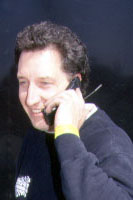|
|
|
||
 |
|||
Dear Larry, I have a back-halved car with ladder bars and coil-over shocks with single rebound adjustment, 9-inch Ford with 4.56 gears and 31x16.5x15 Mickey Thompson ET street tires. I worked with the car this past season (approx. 4 trips to the track) and had major traction problems, i.e. 1.681 60-ft times off the foot brake with Turbo 400 trans. Engine was a mild 383 with 125 hp of nitrous. Best e.t. was 10.19 at 119 mph. I have 6 degrees of pinion angle and varied it a couple of degrees both directions and really couldn’t see a noticeable difference. I have now sold the 383 engine and bought a 540 BBC from Shafiroff Racing and installed a glide with a trans-brake. The engine dyno hp was 837, so I know that I will have a major problem traction-wise when I get the car running. Would like to have some help to keep from killing this engine and myself with the lack of traction that I suspect with the increase in hp and torque. The car weighs 3465 with driver. This is an all-steel car. If I scale the car, what should the weight be from front to rear and side to side and what pinion angle? Any help would be appreciated. Thanks, Dan Devers Haughton, LA Dan, First, before we dicuss pinion angle let’s address weight distribution. Ideally I like to have a minimum of 46 to 47 percent of the car’s total weight on the rear axle on your type of engine-chassis combination. The weight distribution is the determining factor in how well your car will work with the increased torque and horsepower of your new engine. The increased torque and horsepower should help the car launch harder and as a result improve the 60-ft times, provided there are no binding or shock problems in the rear suspension. It’s a good idea to finish the car and chassis before you install your new engine and scale the car. Get the rear weight percentage as close as you can to the 46-47 percent number I mentioned earlier and then make sure the weight across the rear axle from right to left is within 50 lbs. Once you have the chassis weight distribution corrected you can start testing with 3-4 degrees of pinion angle and change it until you get the right result. Good luck next season. Larry I am building a 10.5 car — ’69 Nova, big block, powerglide, 410 gears, ladder bar rear, and double adjustable Afco shocks. What would be the best pinion angle taken with ladder bar level with ground at ride height. I was planning on 2 to 3 degrees, down on pinion. Thanks for your time. Rod Rod, We like to see 1.5" to 2.5" degree of pinion angle on a 10.5-inch tire ladder bar car as a good starting point. However, we have seen cars with as much as 5 degrees of pinion angle do very well. It’s our opinion that it’s okay to run a little more pinion angle as long as you don’t run into problems with the U-joint alignment. Larry Editors note: One of our readers submitted the following addendum to this chassis question. In this instance, this guy is not preloading anything, since his bars do not apply any load at rest. Also, to properly set any suspension or preload, the car must be race ready with the driver in the car. (But you knew that.) I agree with the solid snubbers, but you should also warn him that unless the snubber is directly under the spring eye, he will experience bending of the spring at the contact point. Also, unless you have plenty of tire, some applications need the cushioned shock that a cut off rubber snubber provides. I don't know how old you are, but when I was a kid, Lakewood bars were brand new and high tech. We had lots of trial and error to figure out some of the things that are common knowledge now. I have been impressed by the success that some of your customers have had in recent years, and wish you continued success in the future. -John Harrison
|
|||
|
Copyright 1999, Drag Racing Online and Racing Net Source |
|||
